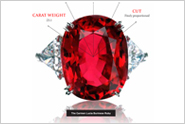Rubies are unquestionably the most sought after of all the precious gemstones in the world, and amongst the most expensive. There are only a few countries in the world that produce rubies, with Myanmar being the industry leader, generating over 80 percent of the world’s supply of these precious stones.
Looking back at history, you will see that gold and silver coins and a variety of precious gemstones have long been used as an established means of bartering for goods and services. Today, natural, unenhanced rubies are among the rarest and most valuable of all gemstones.
As an investment, precious gemstones and diamonds are considered to be an investment in a hard asset, just as gold and silver are. Today, in many parts of the world, investments in hard assets like land, gold and gemstones are preferred over stocks, bonds, currency and other soft assets.
Because the value of gems has shown to increase at a rate equal to inflation, investors should also expect to hold the stones for 10 years or more to see a sizable return on their investment. Furthermore, investors who collect with a purpose will not only add value to a gemstone investment, but also greatly enhance their collection’s intrigue – especially among other collectors and investors.
Star Rubies are even rarer than the average ruby stone. It is estimated that only one out of every one hundred rubies produced becomes what we know as an elusive “Star Ruby”. These incredible gemstones exhibit a distinct six-ray star that moves across the surface of the stone when the stone is moved to reflect a light source. This brilliance represents the precision of the cut, which allows the maximum amount of light to be reflected back to the eye. Stones with lower than 50 to 70 percent brilliance lose light through the sides of the stone due to imperfections of the stone’s angles.
All things considered, it is no wonder these magnificent gemstones are in high demand amongst many private investors. If you’re looking to invest in a ruby and own one of the rarest of rare gems, a ruby with an excellent cut will offer the best mix between the smoothest finish, the heaviest weight and the shape’s precision. When it comes to high quality rubies, heavy stones hold value more consistently than lighter stones.
What to look for
- Clarity – Compare clarity according the American Gemological Laboratory (AGL) clarity guide and look for a Free of Inclusion (FI) rating. “Clarity” represents the internal perfection of the stone, and because investment quality rubies require the highest clarity, you must look for flaws (internal cracks or chips) within the stone. You can see some flaws with the naked eye, but you might need a jeweller’s loupe to view the stone at 10x or 20x magnification.
- Tone – Compare the tone of the ruby, and look for a medium tone score of 55 to 65. Too light a tone and the ruby will appear diluted and washed out. Too dark and the transparency suffers.
- an AGL rating of “excellent”. “Cut” represents the symmetry of the stone’s shape, the weight of the final cut stone and the brilliance of the finish. Investment grade rubies with an excellent cut offer the best mix between the smoothest finish, the heaviest weight and shape’s precision.
- Brilliance – Compare brilliance and look for a minimum rating of 95 percent. “Brilliance” represents the precision of the cut, so that the maximum amount of light reflects back to the eye. Stones with lower than 50 or 70 percent brilliance lose light through the sides of the stone due to imperfections of the stone’s angles.
- Weight – Compare weights and look for a minimum of one carat. “Carat” represents the weight of the stone derived from an ancient measures and weights system. When it comes to investment quality rubies, heavy stones hold value more consistently than lighter stones.
- Certification – Examine the certification agency and look for a score certified by the AGL. The AGL has standardised international guidelines to describe stone quality. Stones graded without a standardised grading certificate might have undisclosed flaws or might not match third party grading systems.
Buy Right
The natural beauty and rarity of gemstones has inspired humanity to use them for personal adornment for as long as history remembers. Some gemstones, such as rubies, can be priced higher than diamonds, as their scarcity endows them with a greater market value. The value of high quality rubies has appreciated tremendously in recent years, as known sources are almost depleted. Owning gemstones not only provides a source of beauty and admiration, but it can also prove to be a sound investment when done right. Anyone can profit from investing in gemstones, as long as you have a strategy that works for you.
Basic tips that you need to know if you are seeking out gems as an investment include:
- Learn as much as possible about the gemstones – Mistakes made in such an investment can be very expensive. For instance, with so many treatments available today, it is imperative that you know the details of any treatments done to your gemstone collection.
- Buy the best stones you can find… And be patient!!! – Gemologists from an approved laboratory must certify all purchases.
- Try to buy below retail prices – Usually, gems bought as an investment should be bought from wholesalers, either as particular gemstones or in lots. Go to reputable dealers or wholesalers who mine or cut the stones themselves. There are many of them in Myanmar – just look for the right ones. It takes patience, but it is certainly worthwhile.










